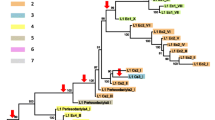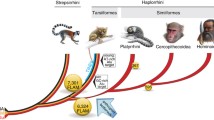Abstract
We identified and characterized the relics of an ancient rodent Ll family, referred to as Lx, which was extensively amplified at the time of the murine radiation about 12 million years ago, and which we showed was ancestral to the modern L1 families in rat and mouse. Here we have extended our analysis of the Lx amplification by examining more murine and nonmurine species for Lx sequences using both blot hybridization and the polymerase chain reaction for a total of 36 species. In addition we have determined the relative copy number and sequence divergence, or age, of Lx elements in representative murine genera. Our results show that while Lx sequences are confined to murine genera, the extent of the amplification was different in the different murine lineages, indicating that the amplification of Lx did not precede, but was coincident with, the murine radiation. The implications of our findings for the evolutionary dynamics of L1 families and the utility of ancestral amplification events for systematics are discussed.
Similar content being viewed by others
References
Aguilar J, Clauzon G, Michaux J (1989) La limite Mio-Pliocène dans le Sud de la France d'après les faune de rongeurs: état de la question et remarques sur les datations a l'aide de rongeurs. Boll Soc Pal Ital 28:137–145
Aguilar J, Michaux J, Bachelet B, Calvet M, Faillat J (1991) Les nouvelles faunes de rongeurs proches de la limite MioPliocene en Roussillon. Implications biostratigraphiques et biogeographiques. Paleovertebrata (Montpellier) 20:147–174
Ameur Chabbar R, Jaeger J, Michaux J (1976) Radiometric age of early Hipparion fauna in North-West Africa. Nature 261:38–39
Ausubel FM, Brent R, Kingston RE, Moore DD, Seidman JG, Smith JA (1989) Current protocols in molecular biology. John Wiley and Sons, New York
Britten RJ, Graham DE, Neufeld BR (1974) Analysis of repeating DNA sequences by reassociation. Methods Enzymol 29:363–418
Burton FH, Loeb DD, Voliva CF, Martin SL, Edgell MH, Hutchison III CA (1986) Conservation throughout Mammalia and extensive protein-encoding capacity of the highly repeated DNA long interspersed sequence one. J Mol Biol 187: 291–304
Carleton MD, Musser GG (1984) Muroid rodents. Orders and families of Recent mammals of the world. John Wiley and Sons, New York, pp 317–345
Casavant NC, Hardies SC, Funk FD, Comer MB, Edgell MH, Hutchison III CA (1988) Extensive movement of LINES ONE sequences in beta-globin loci of Mus caroli and Mus domesticus. Mol Cell Biol 8:4669–4674
Catzeflis FM (1990) DNA hybridization as a guide to phylogenies: raw data in muroid rodents. Evolution of subterranean mammals at the organismal and molecular levels. Wiley-Liss, New York, pp 317–345
Catzeflis FM, Denys C (1992) The African Nannomys (Muridae): an early offshoot from the Mus lineage—evidence from scnDNA hybridization and compared morphology. Israel J Zool 38:219–231
Cech TR, Hearst JE (1976) Organization of highly repeated sequences in mouse main-band DNA. J Mol Biol 100:227–256
Chevret P, Denys C, Jaeger J, Michaux J, Catzeflis F (1992) Molecular and fossil aspects of the tempo and mode of evolution in Otomys (Otomyinae: Muridae: Mammalia). Biochem Syst Ecol 21:123–131
Chevret P, Denys C, Jaeger J, Michaux J, Catzeflis F (1993) Molecular evidence that the spiny mouse (Acomys) is more closely related to gerbils (Gerbillinae) than to true mice (Muridae). Proc Natl Acad Sci USA 90:3433–3436
D'Ambrosio E, Waitzkin SD, Witney FR, Salemme A, Furano AV (1986) Structure of the highly repeated, long interspersed DNA family (LINE or L1Rn) of the rat. Mol Cell Biol 6:411–424
Denys C, Michaux J (1992) La troisième molaire supérieure chez les Muridae d' Afrique tropicale et le cas des genres Acomys, Uranomys, et Lophuromys. Bonn Zool Beitr 43:367–382
Flynn LJ, Pilbeam D, Jacobs LL, Barry JC, Behrensmeyer AK, Kappelman JW (1990) The Siwaliks of Pakistan: time and faunas in Miocene terrestrial setting. J Geol 98:589–604
Furano AV, Robb SM, Robb FT (1988) The structure of the regulatory region of the rat L1 (L1Rn, long interspersed repeated) DNA family of transposable elements. Nucleic Acids Res 16:9215–9231
Hardies SC, Martin SL, Voliva CF, Hutchison III CA, Edgell MH (1986) An analysis of replacement and synonymous changes in the rodent L1 repeat family. Mol Biol Evol 3:109–125
Hattori M, Hidaka S, Sakaki Y (1985) Sequence analysis of a KpnI family member near the 3′ end of human β-globin gene. Nucleic Acids Res 13:7813–7827
Holmes DS, Bonner J (1974) Sequence composition of rat nuclear deoxyribonucleic acid and high molecular weight nuclear ribonucleic acid. Biochemistry 13:841–848
Hunt JA, Hall TJ, Britten RJ (1981) Evolutionary distances in Hawaiian Drosophila measured by DNA reassociation. J Mol Evol 17:361–367
Jacobs LL, Flynn LJ, Downs WR (1989) Neogene rodents of southern Asia. Papers on fossil rodents in honor of Albert Elmer Wood. Los Angeles, Natural History Museum Los Angeles County, pp 157–177
Jaeger J, Hartenberger J (1989) Diversification and extinction patterns among Neogene perimediterranean mammals. Philos Trans R Soc Lond [Biol] 325:401–420
Jaeger J, Tong H, Buffetaut E (1986) The age of the Mus-Rattus divergence: paleontological data compared with the molecular clock. C R Acad Sci 302 (Ser 2):917–922
Jaeger J, Tong H, Buffetaut E, Ingavat R (1985) The first fossil rodents from the Miocene of northern Thailand and their bearing on the problem of the origin of the Muridae. Rev Paleobiol 4:1–7
Loeb DD, Padgett RW, Hardies SC, Shehee WR, Comer MB, Edgell MH, Hutchison III CA (1986) The sequence of a large L1Md element reveals a tandemly repeated 5′ end and several features found in retrotransposons. Mol Cell Biol 6:168–182
Marks J, Schmid CW, Sarich VM (1988) DNA hybridization as a guide to phylogeny: relations of the Hominoidea. J Hum Evol 17:769–786
Martin SL, Voliva CF, Burton FH, Edgell MH, Hutchison III CA (1984) A large interspersed repeat found in mouse DNA contains a long open reading frame that evolves as if it encodes a protein. Proc Natl Acad Sci USA 81:2308–2312
Martin SL, Voliva CF, Hardies SC, Edgell MH, Hutchison III CA (1985) Tempo and mode of concerted evolution in the L1 repeat family of mice. Mol Biol Evol 2:127–140
Mathias SL, Scott AF, Kazazian HHJ, Boeke JD, Gabriel A (1991) Reverse transcriptase encoded by a human transposable element. Science 254:1808–1810
Michaux J, Aguilar J, Bachelet B (1990) La faune des Rongeurs du Sud de la France et sa dynamique au Néogène supérieur. Vie Milieu 40:130–136
Misonne X (1969) African and Indo-Australian Muridae: evolutionary trends. Annal Musée Royal d'Afrique Centrale Tervuuren 172:1–219
Nur I, Pascale E, Furano AV (1988) The left end of rat L1 (L1Rn, long interspersed repeated) DNA which is a CpG island can function as a promoter. Nucleic Acids Res 16:9233–9251
Pascale E, Liu C, Valle E, Usdin K, Furano AV (1993) The evolution of long interspersed repeated DNA (L1, LINE 1) as revealed by the analysis of an ancient rodent L1 DNA family. J Mol Evol 36:9–20
Pascale E, Valle E, Furano AV (1990) Amplification of an ancestral mammalian L1 family of long interspersed repeated DNA occurred just before the murine radiation. Proc Natl Acad Sci USA 87:9481–9485
Rice NR, Straus NA (1973) Relatedness of mouse satellite deoxyribonucleic acid to deoxyribonucleic acid of various Mus species. Proc Natl Acad Sci USA 70:3546–3550
Rogers JH (1985) The origin and evolution of retroposons. Int Rev Cytol 93:187–279
Saiki RK, Scharf S, Faloona F, Mullis KB, Horn GT, Erlich HA, Arnheim N (1985) Enzymatic amplification of β-globin genomic sequences and restriction site analysis for diagnosis of sickle cell anemia. Science 230:1350–1354
Sarich VM (1985) Rodent macromolecular systematics. Evolutionary relationships among rodents. Plenum Press, New York, pp 423–452
Scott AF, Schmeckpeper BJ, Abdelrazik M, Comey CT, O'Hara B, Rossiter JP, Cooley T, Heath P, Smith KD, Margolet L (1987) Origin of the human L1 elements: proposed progenitor genes deduced from a consensus DNA sequence. Genomics 1:113–125
Sheldon FH, Bledsoe AH (1989) Indexes to the reassociation and stability of solution DNA hybrids. J Mol Evol 29:328–343
Sibley CG, Ahlquist JE (1981) The phylogeny and relationships of the ratite birds as indicated by DNA-DNA hybridization. Evolution Today. Carnegie-Mellon University Press, Pittsburgh, pp 301–335
Sutton WD, McCallum M (1972) Related satellite DNA's in the genus Mus. J Mol Biol 71:633–652
Swergold GD (1990) Identification, characterization, and cell specificity of a human LINE-1 promoter. Mol Cell Biol 10: 6718–6729
Weiner AM, Deininger PL, Efstratiadis A (1986) nonviral retroposons: genes, pseudogenes, and transposable elements generated by the reverse flow of genetic information. Annu Rev Biochem 55:631–661
Werman SD, Springer MS, Britten RJ (1990) Nucleic acids: DNA-DNA hybridization. Molecular systematics. Sinauer Associates, Sunderland, MA, pp 204–249
Wilson AC, Ochman H, Prager EM (1987) Molecular time scale for evolution. Trends Genet 3:241–247
Author information
Authors and Affiliations
Additional information
Correspondence to: A.V. Furano
Rights and permissions
About this article
Cite this article
Furano, A.V., Hayward, B.E., Chevret, P. et al. Amplification of the ancient murine Lx family of long interspersed repeated DNA occurred during the murine radiation. J Mol Evol 38, 18–27 (1994). https://doi.org/10.1007/BF00175491
Received:
Accepted:
Issue Date:
DOI: https://doi.org/10.1007/BF00175491




